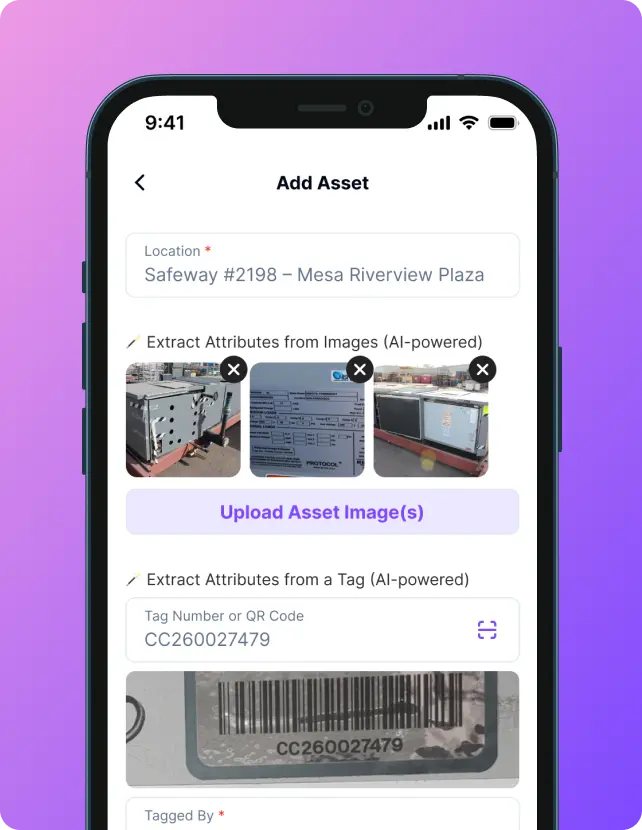
Detect Refrigerant Leaks
Empower Your Team with the Intuitive App That Works Anywhere
The Tag Wizard Difference is that we have worked closely with numerous professionals in the field to train our models, delivering Intuitive Workflows
Driven by Smart Scanning Technology with the ability to adapt to various field scenarios or user requirements.
Stop Losing Time and Money
With Outdated Asset Tracking Methods
Is your business hemorrhaging money through misplaced equipment, inefficient spreadsheet tracking, and endless searches for missing assets?
→ Studies show companies lose up to 30% of their valuable assets annually due to poor tracking systems.
Whether you’re managing IT equipment or even software across multiple locations, tracking tools on job sites, or keeping tabs on inventory in warehouses, manual asset management is costing you thousands in replacement costs, wasted productivity, and compliance headaches.
Our mobile asset tracking app transforms this chaos into organized, real-time visibility that saves time and helps you cut costs from day one.
With our solution, you can easily track assets, ensuring quick localization and efficient management.
Forget manual entry. Embrace AI.
asset tagging app
that brings true ✨ AI automation ✨ to the field.Smart Nameplate Scanning (Unique to Tag Wizard)
Just take a picture of equipment nameplates or asset tags, and Tag Wizard's unique AI automatically reads and extracts all the details, filling in your forms instantly and ensuring information is perfectly aligned.
Hands-Free Voice Entry
We know your hands are busy. With talk-to-text functionality, simply tell the app what you're looking at, and it will fill in the asset data while you multitask, phone in one hand, wrench in the other.


Driven by intuitive workflows and field adaptability.
Guided Task and Inspection Lists (Soon!)
Empower your technicians with a structured, step-by-step asset task list linked to specific equipment types. Ensure every inspection, maintenance log, and compliance check is completed accurately and documented perfectly, every time. Easily record and access detailed asset history to improve accountability and support compliance requirements.
Future-Proof Tagging
Supports instant Barcode and QR code scanning, and is ready for NFC (Near Field Communication) and the latest Bluetooth (BLE) beacons for maximum flexibility and rapid tap-to-read functionality. Tie the Beacon to the asset and close the loop on the types of devices in your workplace or across your entire asset empire
The Tag Wizard Difference: Magic in Every Detail
Our asset management software stands out from traditional asset tracking solutions:
Advanced AI Technology
Our scanning engine reads damaged, dirty, or partially obscured barcodes that other asset tracking apps struggle with
Smart Auto-Sync
Automatically synchronizes asset data across all devices and integrates with a cloud platform for real-time data sharing and scalability, ensuring data integrity across your entire team
Industry-Specific Templates
Pre-configured setups for construction companies, datacenters, groceries and healthcare facilities, and manufacturing businesses to start tracking immediately, supporting company-wide asset management across multiple locations or departments
What our clients are saying
⭐ ⭐ ⭐ ⭐ ⭐ “We reduced asset loss by 85% and cut inventory audit time from 3 days to 3 hours. The mobile app works perfectly on our construction job sites, even without cell service.”
⭐ ⭐ ⭐ ⭐ ⭐ “We sped up the tagging process. It's a cool novelty to let the app do the typing for us. Also, it knew which data I had to collect, so all I had to do was point and click.”
⭐ ⭐ ⭐ ⭐ ⭐ “Finally, an asset tracking solution that our entire team actually uses. The barcode scanning is incredibly fast, and the real-time visibility has transformed how we manage our IT devices.”
Frequently Asked Questions
Asset tagging is the process of assigning a unique identifier to each refrigerant asset, enabling it to be tracked and managed throughout its lifecycle.
This identifier can be a physical tag, such as a barcode or RFID tag, or a digital tag, like a software asset tag.
Refrigerant asset tagging is a cornerstone of effective asset management, allowing organizations to keep track of their assets, reduce losses, and streamline maintenance and repair activities.
By implementing a robust refrigerant asset tagging system, you can ensure that every piece of equipment is accounted for, maintained properly, and utilized efficiently.
Absolutely! Our app works with any barcode or QR code format, so you can keep your current asset tags and start tracking immediately.
Bank-level encryption protects your asset information with secure cloud storage, automatic backups, and role-based access controls to protect your intellectual property and business assets.
Our mobile app works on iOS 12+ and Android 8+ smartphones and tablets. Access your asset data from any web browser on desktop computers, too.
Stop losing valuable assets.
Boost productivity with an asset tracking solution that actually works.
Join thousands of companies that’ve transformed their asset management with our mobile-first platform. Download our free app and start tracking in minutes. No credit card required for Starter Plan. 30-day money-back guarantee on paid plans.
